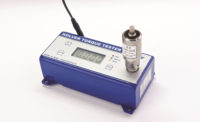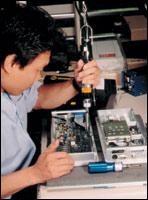
Although electronic devices have become faster, smaller, smarter and more energy-efficient, simple ESD still lurks as a constant danger. Given today's operating voltages of as little as 1.5 volts and chip-set traces measuring only 400 angstroms in width, the risk of ESD damage is greater than ever. Any lapses in preventing its occurrence can affect production yields, manufacturing costs, product quality, product reliability, reputation and profitability. Industry experts have estimated average product losses due to ESD to range from 8 to 33 percent (Stephen Hal-perin, "Guidelines for Static Control Management," Eurostat, 1990).
Many manufacturing and quality control engineers already take some preventive measures, such as the use of wrist and heel straps, to exorcise ESD from their assembly lines. But, fastening tools are often overlooked. If the tools lack sufficient grounding, your products are still at risk.
A quick review of the fundamentals of static electricity, as they apply to the manufacturing environment, can help elucidate the significance of ensuring that all fastening tools are ESD-safe.
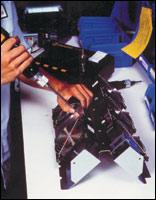
Electrostatic Principles
The most common way to create an electrostatic charge is through friction, or triboelectric charging. When two dissimilar materials are rubbed together and separated, a transfer of electrons from one material to the other may occur. The amount of static electricity that is generated depends on the material, the amount of friction and the relative humidity of the environment. A significant electrostatic charge can be generated by wiping a glass with silk, rubbing a balloon against a wool sweater--or sliding a plastic-encased electric screwdriver across a metallic work surface.When any difference in electrostatic potential exists between two objects, a transfer of electrons occurs between the charged materials so their potentials become balanced. This exchange of energy constitutes the electrostatic discharge, and it takes place within microseconds or nanoseconds.
Static electricity can be conducted to an assembly through the human body or a machine. The most common cause of damage usually occurs through the direct transfer of electrostatic charge from the human body to the ESD-sensitive device. Most preventive measures, such as wrist straps, focus on this channel of transference.
However, equally damaging discharges can occur from a charged conductive object, such as a metallic tool. A worker may be totally grounded, but if he brings a sensitive component or circuit card in contact with an ungrounded electric screwdriver, ESD damage can still occur. Electrostatic charges can build up on most fastening tools. Unless those charges are dissipated or prevented, damage to the components can result.
For example, many drivers are built with a plastic housing. Insulators, such as plastics, can build and store large electrical charges. On the other hand, most enclosures and cabinets are made of highly conductive metals. When an insufficiently grounded driver contacts a conductor, a static electrical charge bleeds off instantaneously at extremely high voltage.
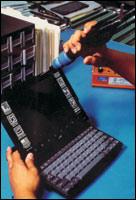
The Effects of ESD
Even at ESD voltages of less than 200 volts, gate oxide destruction can occur in a semiconductor, completely changing its electrical characteristics. Low ESD voltages can also cause junction failure where the bonding wire attaches to the package leads.These levels of electrostatic discharge hover well below what humans can normally feel, which is approximately 3,000 to 4,000 volts. As a result, most electrostatic discharges pass unnoticed by assemblers, especially when using an electric screwdriver. The assembler switches it on and hears only the whir of the motor. Any noises caused by static arcs through the air cannot be heard.
The damage done by ESD takes two forms: catastrophic failure and latent failure. Catastrophic failure renders the component or circuit card instantly defective. Basic quality and performance tests detect these failures long before product shipment. In this case, swapping out the damaged part or card immediately rectifies the problem.
Latent failures are less obvious. A device exposed to ESD may be partially degraded, yet continue to perform its intended function throughout the testing process. However, once the device gets shipped to the customer and placed in the field, its operating life may be drastically shortened. Because latent defects are difficult to detect by any process other than examining parts under an electron microscope, prevention stands as the most effective weapon of defense.
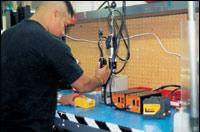
Preventing Damage
Manufacturing engineers possess an arsenal of products to prevent ESD. Most of these measures, such as wrist or heel straps, shoe covers and conductive mats, only focus on the human model. Yet, these preventive measures are for naught if the tools used in assembly lack the necessary grounding."Even with all the protection normally employed, you still need grounded tools because you can't be too sure," notes George Kirkpatrick, a senior manufacturing engineer for 30 years at Aerojet Electronic Systems (Azusa, CA). "You don't know where the assembler might set the tool down or what the tool is lying against.
"Also, what if someone fails to put on their wrist strap? You could end up having to scrap an expensive one-off part for a simple lapse in procedure. But if the tool is grounded, then it acts as the wrist strap, and you have now protected the product through the tool. This could save you untold trouble down the line."
Correctly grounding an electric screwdriver or nutrunner involves more than merely adding a pigtail to the end of the power cord. With many drivers, the plastic housing used for the body can generate a significant static charge by itself. Some drivers do not even have a direct connection between the bit and the rest of the tool.
Ideally, fastening tools should have an uninterrupted ground path from the bit to the power outlet. To maximize the path for dissipating static charges, the resistance between the part to be fastened and earth-ground should be less than 1 ohm. To achieve that, the tool housing should be made of nylon or other conductive material. The chuck and motor assembly should be built to dissipate charges, and the covering of the cable that leads from the driver to the control transformer should be protected. The transformer should also be fully grounded. Some tool manufacturers do not take this precaution, so engineers should ensure that every screwdriver is linked with its original equipment transformer.
"One careless slip can jeopardize a multimillion dollar project," observes Kirkpatrick, "so you can't afford to be too careful. We spend hundreds of thousands of dollars each year on ESD prevention, and that includes utilizing the proper tools."
The competitive market of today's electronics industry no longer permits mistakes on the manufacturing floor. Any organization that fails to fully recognize the very real phantom of ESD runs the risk of losing market share to those companies that avail themselves of every available defense against ESD.
For more information about grounded tools, contact Mountz at 800-456-1828, visit www.mountztorque.com, or Reply 20.
